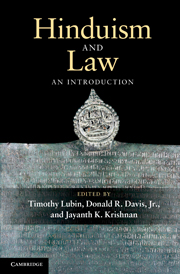Book contents
- Frontmatter
- Contents
- List of contributors
- Acknowledgements
- Chronology
- Abbreviations
- Map South Asia: political divisions c. 1860 and today
- Introduction
- Part I Hindu law
- Chapter 1 A historical overview of Hindu law
- Chapter 2 Dharmaśāstra
- Chapter 3 The practice of classical Hindu law
- Chapter 4 The creation of Anglo-Hindu law
- Chapter 5 Marriage and family in colonial Hindu law
- Chapter 6 Hindu law as personal law
- Part II Law in ancient and medieval Hindu traditions
- Part III Law and modern Hinduism
- Glossary
- Bibliography
- Index
Chapter 4 - The creation of Anglo-Hindu law
Published online by Cambridge University Press: 05 June 2012
- Frontmatter
- Contents
- List of contributors
- Acknowledgements
- Chronology
- Abbreviations
- Map South Asia: political divisions c. 1860 and today
- Introduction
- Part I Hindu law
- Chapter 1 A historical overview of Hindu law
- Chapter 2 Dharmaśāstra
- Chapter 3 The practice of classical Hindu law
- Chapter 4 The creation of Anglo-Hindu law
- Chapter 5 Marriage and family in colonial Hindu law
- Chapter 6 Hindu law as personal law
- Part II Law in ancient and medieval Hindu traditions
- Part III Law and modern Hinduism
- Glossary
- Bibliography
- Index
Summary
Anglo-Hindu law was born in Calcutta on August 21, 1772, when the Bengal government adopted “A Plan for the Administration of Justice in Bengal” (usually referred to as the Judicial Plan) framed by Orientalist Governor (later Governor-General) Warren Hastings. Seven years after the Mughal emperor had granted the East India Company the diwani (revenue collection) of the provinces of Bengal, Bihar, and Orissa, Hastings was bringing to an end an initial “dual system” of government, and assuming full British control. Hastings was particularly concerned at the chaotic state of the court system and of the administration of law. In addition to setting up a pyramid of British courts, the Judicial Plan laid out principles on which judgments were to be rendered. These were the foundation of Anglo-Hindu law, which was to evolve to meet further concerns of the colonial administration.
Quest for legitimacy
The first question the newly empowered British administration faced was which laws should be applied in their new courts. Military officer and leading historian Alexander Dow opined in “An Inquiry into the State of Bengal,” prefixed to the third volume of his History of Hindostan, that by reason of conquest and since Indians were divided into religious communities that would not submit to the laws of one another, it was “absolutely necessary for the peace and prosperity of the country” that the laws of England should prevail (Dow 1770–2, vol. iii: cxliii). Hastings and fellow Orientalist administrators were, to the contrary, of the opinion that imposing foreign, English law on Indians was unwarrantably coercive, and potentially dangerous. At a time when the English East India Company had a still tenuous hold on limited coastal territories, and when its civil servants did not yet entertain “the illusion of permanence” (title of Hutchins 1967), ruling in ways that would arouse as little dissatisfaction and unrest as possible was deemed prudent. Respecting the personal laws, or “prejudices,” of the natives was a central element in their policy. Yet the British were as ignorant of the laws by which Indians abided as Indians were of English law. Hastings’s plan put the burden on the British to be the learners.
- Type
- Chapter
- Information
- Hinduism and LawAn Introduction, pp. 78 - 88Publisher: Cambridge University PressPrint publication year: 2010
- 13
- Cited by



